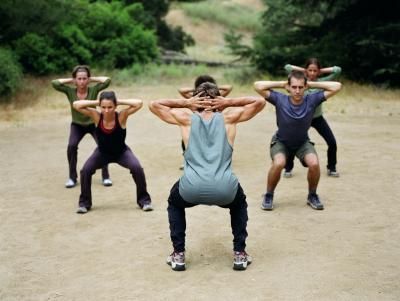It was the most challenging class I had led in a while, Mark said as he put on his jacket. It might have been the toughest I had ever done at the YMCA.
"Really?" I asked. It didn't seem that bad. Then again, I wasn't completing the 4-minute rounds that alternated between cardio and resistance training. I was doing part of them, yes, but I definitely wasn't going rep for rep.
But still, I followed up, "don't you expect boot camp to be hard?"
I was sitting in my program director's office, squaring up schedules and training, when he asked me if I could fill in for a few Tuesday nights. One instructor was cutting back on classes and while a replacement was lined up, she still needed some training.
"It's on the schedule as T-N-T," he said, "but she's been doing it as a boot camp. You can just keep that up."
I am not sure what it was about that day and that conversation but ever since, I've really been putting thought into what a boot camp class is – and what it should be. It's easy to fall into the trap of making it the hardest class possible (as I implied when talking to Mark) but the problems with that are a) many people attending group fitness classes in a YMCA-like setting aren't ready for such a class; and b) it is my belief that each class/module should have an objective or goal. I think a lot of people like to label classes "boot camp" because it is more inclusive (you are more likely to get men in the door) and it sounds trendy.
But that's not a good reason.
According to ACE, the organization through which I earned my personal training certificate, an exercise boot camp incorporates exercises that improve strength, agility, power, speed, strength and balance. The Mayo Clinic reports that the appeal of boot camps is that the class builds "strength, endurance and agility to conquer your daily routine"and includes intense aerobic and resistance elements. As for the Y? The schedule describes my class as "a challenging interval class with a variety of drills and power moves to increase agility, "cardio" and overall strength for the ultimate calorie burn."
For comparison, the T-N-T class is listed as "a muscle conditioning work out designed for improving overall strength and endurance."
Even with the definitions, it's still a broad fitness category. And so what's an instructor to do? Well, not make the class as hard as possible – I'll tell you that much.
For me, it's meant that I've stepped back and really put thought into the why of the workout and not the what. It's not about doing three kinds of burpees or four variations of jumps. It's about using heavy weights to build strength or doing lateral movements to improve agility. It's not about incorporating the craziest, most complicated moves from the most recent issue of a magazine but choosing moves that improve functional fitness that participants recognize and can perform with good form. It's not about earning a reputation for being a badass instructor but leading participants through a safe workout.
But don't be fooled by my soap box – safe doesn't equal easy.
Last night's boot camp workout included 4-minute work sessions that focused on performing a move for 45 seconds and then a more intense exercise/version for 15 seconds. The class rested for 2 minutes between rounds, and the rounds alternated between cardio and resistance.
Sample cardio round (repeat twice):
Shuffle side to side (45 seconds)
Squat jack (15 seconds)
Back pedal (45 seconds)
Scissor jack (15 seconds
Sample resistance round (repeat twice):
Deadlift with bentover row (45 seconds)
Isometric row hold (15 seconds)
Single leg deadlift with flye* (45 seconds)
Single leg pulse* (15 seconds)
* Do one side/leg per round
A couple of notes:
• I like to program classes in terms of time rather than reps because not everyone works at the same pace. I find that it improves self efficacy if a participant doesn't feel behind, and it also improves form because they aren't worried about keeping up.
• I offer modifications/challenges for most exercises in a workout. Squat jacks become tap outs and scissor jacks become an alternating lunge with a limited range. If I have a good group, I'll challenge participants to take the squat jack to a tuck jump.
• I am just sharing this as an example. If you choose to incorporate these sets into a workout, you do it at your own risk.
• If you want me to share the whole workout, let me know in the comments. I will add a graphic with the information. I might even get super (insert adjective here) and make it pinnable.
Now, with that out of the way, tell me: What do you think are the components of a good boot camp workout?


I would love the entire workout!
ReplyDelete